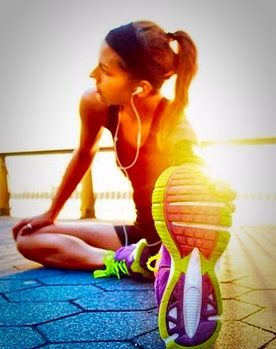Feeling stiff? Well if you are, static stretches aren’t the answer. It turns out that static stretching exercises before a run spoils performance, especially in young runners.
A recent study by Paradisis et al. found that pre-run static stretching significantly inhibited sprinting performance in young forefoot runners.

Why Runners Should Forget About Static Stretches
The researchers found that pre-run static stretching of the quads, hamstrings, hip extensors and plantar flexors reduced sprinting performance by 2.5% compared with the non-stretch young forefoot runners. The findings add to the nebulous concept of stretching before running: static stretching improves flexibility at the cost of reduced performance.
Even more scary, 6 other studies found that pre-run static stretching had empty influences on running performance. What is the point of pre-run static stretching then?
Complicating the picture, the results also showed no differences between genders meaning that static stretching before running did not affect girls more than boys or vise versa. This contradicts the belief that girls are more fragile than boys and therefore young female runners should stretch more to avoid injury and performance loses. However, both genders in the study did not benefit economically from pre-run static stretching.
Why Static Stretching Before Running Impairs Performance
A study by Nelson at el. found that muscle strength dropped continuously after pre-run static stretching which reduced endurance performance. How did this happen?
- Pre-run static stretching induced certain motor-units into a fatigued-like state thereby depleting the amount of motor units needed to maintain good performance.
Basically, pre-run static stretching causes a runner to bottom out early with respect to performance.
The Take Home Message
It is becoming clearer that static stretching before running is not a natural part of running.
Our ancestors never stretched before their 12-15 km daily barefoot run which in around-about way suggests why performance degrades more quickly with pre-run static stretching.
Nevertheless, stretching is not part of our natural behavior in the context of running as we seem to be more physically vulnerable when we stretch.
More From Run Forefoot:
Running barefoot has been proven to prompt better mechanics during speedwork.
Regularly running barefoot will give you the foot/ankle strength you need to avoid lower leg injury.
How to accelerate and decelerate in forefoot running.
Revive your mood and energy level with these water-soluble energy tablets.
Most recommended barefoot running shoes for forefoot strike running.
3-step advanced training guide for barefoot running beginners.
References:
Fletcher, IM and Anness, R. The acute effects of combined static and dynamic stretch protocols on fifty-meter sprint performance in track-and-field athletes. J Strength Cond Res 21: 784–787, 2007.
Fletcher, IM and Jones, B. The effect of different warm-up stretch protocols on 20 meter sprint performance in trained rugby union players. J Strength Cond Res 18: 885–888, 2004.
Kistler, BM, Walsh, MS, Horn, TS, and Cox, RH. The acute effects of static stretching on the sprint performance of collegiate men in the 60- and 100-m dash after a dynamic warm-up. J Strength Cond Res 24: 2280–2284, 2010.
Mohammadtaghi, AK, Sahebozamani, M, Tabrizi, KG, and Yusof, AB. Acute effects of different stretching methods on Illinois agility test in soccer players. J Strength Cond Res 24: 148–156, 2010.
Nelson, AG, Kokkonen, J, and Eldredge, C. Strength inhibition following an acute stretch is not limited to novice stretchers. Res Q Exerc Sport 76: 500–506, 2005.
Robbins, JW and Scheuermann, BW. Varying amounts of acute static stretching and its effect on vertical jump performance. J Strength Cond Res 22: 781–786, 2008.
Bretta Riches
BSc Neurobiology; MSc Biomechanics candidate, ultra minimalist runner & founder of RunForefoot. I was a heel striker, always injured. I was inspired by the great Tirunesh Dibaba to try forefoot running. Now, I'm injury free. This is why I launched Run Forefoot, to advocate the health & performance benefits of forefoot running and to raise awareness on the dangers of heel striking, because the world needs to know.
Latest posts by Bretta Riches (see all)
- Can You Run In Barefoot Shoes? Yes, But DON’T Heel Strike! - 21/07/2024
- Why Cushioned Running Shoes Are Really Bad for Your Feet - 19/07/2024
- Do Cushioned Running Shoes Cause Injuries? - 17/07/2024

Leave a Reply